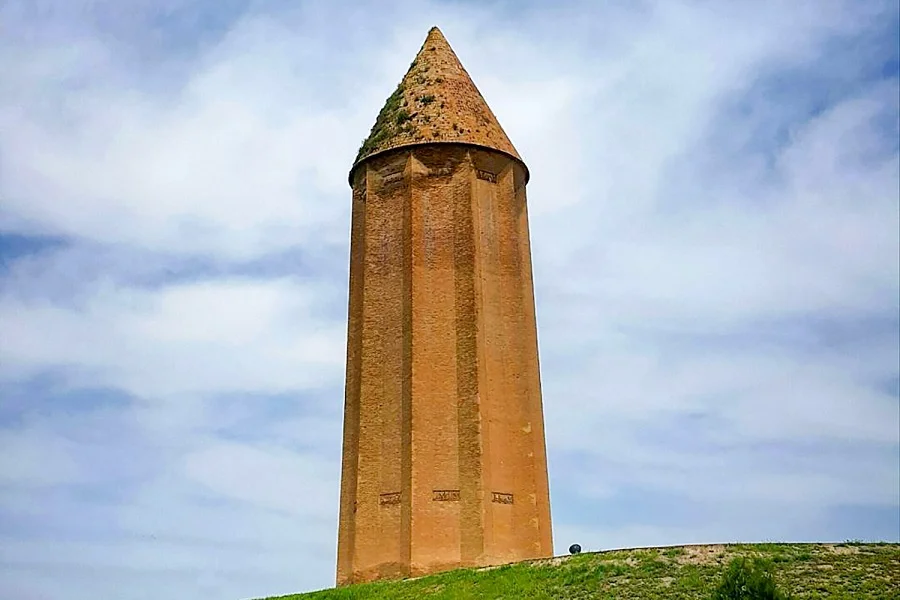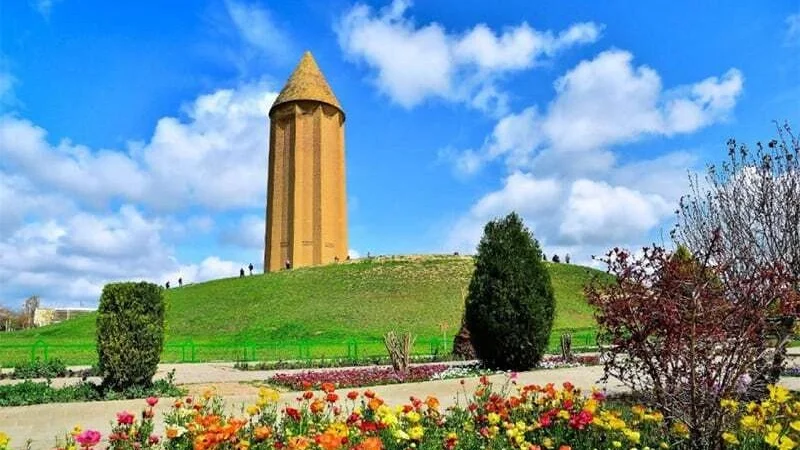
Gonbad-e Qabus
The ancient Gonbad-e Qabus Tower, a UNESCO World Heritage site in Iran, showcases some of the finest Islamic architecture from the 4th century AD. Known also as Gonbad-e Kavus, this remarkable tower reaches 15 meters above the ground and was constructed in 375 Solar Hijri during the reign of Qabus-ibn Wushmgir. Though it has minimal decorative features, the tower’s strong, symmetrical design has made it the world’s tallest brick structure—a marvel of engineering and historical elegance.
Gonbad-e Qabus: An Iconic Brick Tower in Iran
Gonbad-e Qabus, the world’s largest brick tower of its kind, stands as one of Iran’s most significant tomb towers and is a UNESCO World Heritage site, recognized for its cultural heritage. Built in the 10th century during the rule of Qabus, the son of the Ziarid king Vushmgir, this tower’s simple yet impressive design features only burnt bricks. The tower’s purpose remains a topic of discussion; many believe it served as the tomb and resting place of Qabus Ibn-e Vushmgir, the Ziarid king who governed northern Iran in the 10th and 11th centuries.
There’s no way to confirm or refute this theory, as no remains have been found in the tower’s cellar. Some believe that Qabus, known for his connections with scholars, writers, and astronomers, intended the structure as an observatory. Historical records even suggest that Qabus himself commissioned the tower’s construction. Whatever its purpose, Gonbad-e Qabus stands as a remarkable example of ancient architecture, capturing the attention of all who pass by. This tower preserves an essential chapter of Iranian art and architectural history.
Architectural Design & Key Features of Gonbad-e Qabus
The architecture of Gonbad-e Qabus blends early Razy and Khorasan styles, showcasing fine craftsmanship with durable baked bricks used throughout the structure. Its resilience is remarkable, withstanding time, weather, and other challenges. The tower features a conical roof, a circular exterior, and stands at 52 meters in height. It is built atop a 10-meter artificial hill, giving it a prominent foundation. The tower’s outer circumference measures 60 meters, while the inner perimeter spans 30 meters, with a base diameter of 9.67 meters.
Breaking Down the Three Key Sections of Gonbad-e Qabus Tower
The structure of Gonbad-e Qabus is typically described in three main sections. These parts include:
Foundation
As mentioned earlier, Gonbad-e Qabus is constructed on a man-made hill, utilizing bricks and “Sarooj,” a traditional Iranian concrete. Like other tomb towers, it features a cellar within its foundation. Unfortunately, over the years, looters searching for treasure have left behind very little of what once existed.
Body
Gonbad-e Qabus is encircled by right-angled buttresses that create striking silhouettes, enhancing its beauty throughout the day. Its unique position atop a hill, slender design, and pointed roof set it apart from other ancient towers. The tower features a single entrance facing southeast, adorned with trilobed niches at the top. Notably, this tower also showcases one of the earliest examples of muqarnas (stalactite vaulting).
Conical Roof
The conical roof stands tall at 18 meters and features a 9-meter diameter at both its interior and base. Constructed with baked bricks, this impressive roof showcases the architect’s craftsmanship.

Gonbad-e Qabus Construction Materials
The roof of Gonbad-e Qabus was crafted using Sarooj and special tailed bricks known as “Kafshaky.” It features two layers: the outer shell, made of tailed bricks, and the inner shell, shaped like a half-egg and constructed from regular burnt bricks. Despite being over a thousand years old and lacking a substantial subsurface foundation, this tomb tower has withstood powerful earthquakes with magnitudes up to 6 on the Richter scale, thanks to its solid placement. The architect utilized the “Compaction” method, compressing the earth in a spiral or stepped pattern around the façade, which ultimately formed the hill at the tower’s base.
Decoration at Gonbad-e Qabus Tower
At the top of the tower, you can see a muqarnas corner in a semicircular design, representing the first instance of ornamentation. Surrounding the tower’s trunk are Kufic inscriptions that create a decorative belt, with one inscription standing 8 meters tall and the other positioned just below the dome. The lettering is made of embossed bricks in a clear and simple Kufic style. Additionally, a brick frame has been constructed around the inscriptions.
Tomb Towers in Iranian History and Their Roles
In ancient times, people built tower-like structures along roads, routes, and city borders, known as “Meel,” “Menar,” “Cheraghdan,” or “Cheragh Payeh.” The term “Menar” means a place of fire and light. Fires were lit on top of these towers to guide travelers during the night or in foggy conditions, as well as to send messages over long distances. During the Sassanid era (3rd to 7th centuries), these towers were transformed into fire temples, where Mubads (Zoroastrian priests) were appointed to maintain the sacred fire.
Since the advent of Islam, Iranians have built tomb towers to honor their respected figures. This practice continued until the seventh century when the Arabs introduced Islam to Iran. The new religion initially discouraged the creation of memorials for the deceased, leading to a temporary decline in this tradition. However, even after embracing Islam, Iranians made significant efforts to revive this custom within their communities.
Between the 11th and 13th centuries, approximately 400 to 600 years after the arrival of Islam, the construction of tomb towers became popular again in Iran. During this period, thirty Meel or Menar towers were built. The oldest surviving example is the “Meel-e Ezhdeha,” located in Mamasany Town, which dates back to the Parthian Era.
Additional Historical Attractions in the City
At the entrance of Gonbad-e Kavus lies an ancient bazaar known as the Russian Bazaar, which serves as one of the city’s main commercial centers. This indoor market is popular and features numerous shops lining both sides. Don’t miss the chance to visit Imamzadeh Yahya ibn Zayd, where the descendant of a Shia Imam is interred. Built in 738, the Emamzadeh has undergone several renovations over the years. Imamzadeh Yahya ibn Zayd is recognized as a prominent religious scholar from Golestan province, attracting many pilgrims and tourists daily. As a result, the site is often bustling with visitors.
Natural Attractions in Gonbad-e Kavus
Here’s a list of some breathtaking places in the vicinity of Gonbad-e Kavus:
Located on the Gorgan River in the northeastern part of Gonbad City, the Golestan Dam offers stunning surroundings and is one of the top tourist attractions in Gonbad-e Kavus.
Wetlands of Alma Gol, Aji Gol, and Ala Gol
These wetlands are also noteworthy natural attractions in the area, providing beautiful landscapes and diverse wildlife.
Gonbad-e Kavus is home to several natural features, including the Alma Gol, Aji Gol, and Ala Gol marshes. During migration season, a variety of bird species flock to these lagoons, creating breathtaking scenery.
The Alma Gol Wetland is located near the Iran-Turkmenistan border, just north of Tangeli Village, covering an area of 207 hectares. The Aji Gol Wetland is situated to the south of Tangeli Village, while the Alma Gol and Ala Gol marshes are separated by this 360-acre wetland. The Ala Gol Wetland is approximately 60 kilometers to the north of Gonbad-e Kavus. The lagoon bed is primarily covered in green algae and is surrounded by tamarisk trees and common reeds.
Hivehchi-ye Bala Village
Located 17 kilometers southwest of Gonbad-e Kavus along the road to Aq Qala, Hivehchi-ye Bala Village is a charming settlement that attracts visitors to the area surrounding the Kavus Dome. The village boasts breathtaking natural beauty, making it an ideal spot for camping enthusiasts.
Visiting Hivehchi-ye Bala throughout the different seasons offers unique experiences and surprises. The area around the village provides a wonderful setting for camping and enjoying peaceful nights under the expansive sky of the plain. If you take the time to explore this village, you are sure to find tranquility in its serene environment.
Gonbad-e Kavus Artificial Lake
Located at the entrance of Gonbad-e Kavus, this artificial lake is a popular gathering spot in the city, covering an area of five hectares. Its close proximity to Shadi Park and the surrounding resorts enhances the appeal of this recreational area, making it an inviting destination for visitors.
Equestrian Center
The Gonbad-e Kavus Equestrian Complex is a sprawling facility that includes parking, lush green areas, a horse racing track, suites, villas, winter and summer stables, competition grounds, and swimming pools. Located on Moallem Boulevard in the northeastern part of Gonbad-e Kavus, this complex attracts spectators from across the country for its spring and fall horse races. Visitors can enjoy the beautiful scenery of the area, which is near the Caspian Sea and home to a nomadic population. The complex offers something for everyone, making it a great destination for fans of Iran’s historical and natural attractions.

Best Times to Explore Gonbad-e Qabus
Gonbad-e Kavus experiences long, cold winters that are dry and partially foggy, while summers are hot, humid, arid, and clear. The average annual temperature ranges from 38 to 96 degrees Fahrenheit, with temperatures rarely dropping below 29 or exceeding 103 degrees. The best time to visit Gonbad-e Kavus for outdoor activities is from early June to late September, when the weather is warmest.
Final words
This region of Iran is perfect for international visitors seeking cultural and natural attractions. Located southeast of the Caspian Sea and northeast of Tehran, Golestan Province offers a wealth of cultural experiences, including the Hyrcanian Forest and the lifestyle of the local Turkmen tribes. Be sure to include a visit to the Gonbad-e Qabus tomb tower during your stay. Despite its historical significance, the journey to this remarkable site is well worth the time and effort.


I was recommended this website by my cousin I am not sure whether this post is written by him as nobody else know such detailed about my trouble You are amazing Thanks